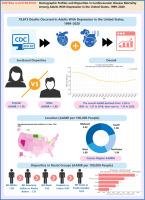1999年至2020年成人抑郁症相关心血管疾病死亡率的趋势:美国的一项回顾性研究
IF 5.9
Q1 CARDIAC & CARDIOVASCULAR SYSTEMS
引用次数: 0
摘要
背景:心血管疾病(CVD)和抑郁症经常共存,导致比单独CVD更差的结局和更高的死亡率。尽管有这种影响,成人抑郁症患者心血管疾病死亡率的长期趋势仍未得到充分研究。方法使用CDC WONDER数据库获取1999 - 2020年年龄≥25岁成人的死亡证明数据。提取每10万人的年龄调整死亡率(AAMRs)和粗死亡率(CMRs)。使用Joinpoint回归估计年变化百分比(APC)和平均APC (AAPC),并使用两两比较与一般人群进行比较。结果成人抑郁症患者共发生79,813例心血管疾病死亡。死亡率趋势在2002年之前保持稳定(APC: 0.14),到2010年显著下降(APC: -6.87), 2010 - 2018年保持相对稳定(APC: -0.80),然后在2020年之前显著上升(APC: 8.52)。AAPCs与一般人群有显著差异。女性的aamr始终高于男性,在NH白人中最高,其次是NH黑人或非裔美国人,西班牙裔/拉丁裔美国人,以及NH亚洲人或太平洋岛民。AAPCs的区域差异(中西部:2.2,西部:1.7,东北部:1.5,南部:1.4),与中西部和东北部的一般人群不同。非都市地区的aamr(2.2)高于都市地区(1.6)。在所有分析的年龄组(45-54岁至85岁以上)中,cmr的apc与一般人群有显著差异。结论:自2018年以来,成年抑郁症患者的心血管疾病死亡率有所上升,存在性别、种族和地理差异。这些发现强调需要采取有针对性的干预措施来降低这一高危人群的死亡率。本文章由计算机程序翻译,如有差异,请以英文原文为准。

Trends in depression related cardiovascular mortality among adults from 1999 to 2020: a retrospective study in the United States
Background
Cardiovascular disease (CVD) and depression frequently coexist, leading to worse outcomes and higher mortality than CVD alone. Despite this impact, long-term trends in cardiovascular mortality among adults with depression remain underexplored.
Methods
We used the CDC WONDER database to obtain death certificate data from 1999 to 2020 for adults aged ≥25 years. Age-adjusted mortality rates (AAMRs) and crude mortality rates (CMRs) per 100,000 population were extracted. Annual percent change (APC) and average APC (AAPC) were estimated using Joinpoint regression and compared to the general population using pairwise comparison.
Results
A total of 79,813 CVD deaths occurred in adults with depression. Mortality trends were stable until 2002 (APC: 0.14), declined significantly through 2010 (APC: -6.87), remained relatively stable from 2010 to 2018 (APC: -0.80), then rose significantly until 2020 (APC: 8.52). AAPCs differed significantly from the general population. AAMRs were consistently higher in females than males and highest among NH Whites, followed by NH Black or African Americans, Hispanics/Latinos, and NH Asian or Pacific Islanders. Regional variation in AAMRs was noted (Midwest: 2.2; West: 1.7; Northeast: 1.5; South: 1.4), with AAPCs differing from the general population in the Midwest and Northeast. AAMRs were higher in non-metropolitan (2.2) than metropolitan areas (1.6). APCs for CMRs in all analysed age groups (45–54 to 85+) differed significantly from the general population.
Conclusion
CVD mortality rates among adults with depression have risen since 2018, with disparities by sex, race, and geography. These findings underscore the need for targeted interventions to reduce mortality in this high-risk population.
求助全文
通过发布文献求助,成功后即可免费获取论文全文。
去求助
来源期刊

American journal of preventive cardiology
Cardiology and Cardiovascular Medicine
CiteScore
6.60
自引率
0.00%
发文量
0
审稿时长
76 days
 求助内容:
求助内容: 应助结果提醒方式:
应助结果提醒方式:


